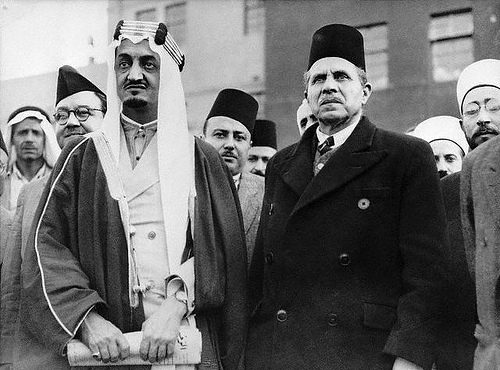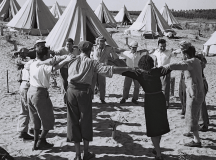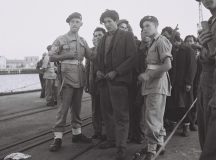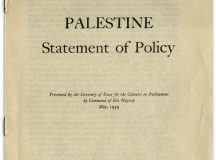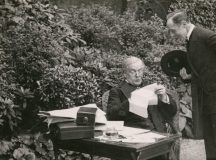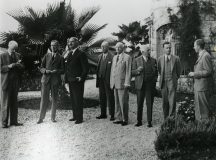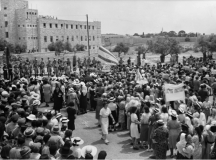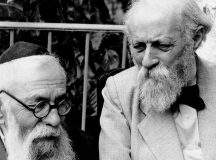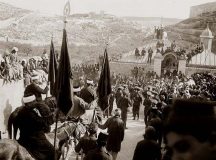The editors thank Bloomsbury Academic (US), an imprint of Bloomsbury Publishing Inc., for permission to reprint this chapter, a survey of differing Palestinian reactions to the partition plan, as part of our Mandate100 series. The chapter is reproduced from The Two-State Solution: The UN Partition Resolution of Mandatory Palestine – Analysis and Sources, edited by Ruth Gavison, 2013.
Background
It is fitting to open the discussion about the Palestinians’ position vis-à vis the idea of dividing the country between the two peoples—a principle which had been agreed upon by numerous committees and international bodies—and their reaction to it with the fact that grave concern accompanied the reactions of the Palestinians to the proposals and declarations pertaining to the future of the country ever since the end of the First World War and the disintegration of the Ottoman Empire. Their concern was that this idea would lead to their being disinherited from their homeland and to the expunction of their identity, which they viewed as part of the regional Arab identity. Their resistance to the Balfour Declaration and the Mandate stemmed first and foremost from the concept governing these two documents, which ignored the distinctive identity of the Palestinians and saw the Arabs residing in the country as a mass of different religious groups. It is amazing that several scholars have written things that imply a criticism of the fact that Palestinians objected to the Balfour Declaration.[1] One wonders if these writers tried to answer the following question which is so pertinent here: Why did the Palestinians need to accept a declaration which did not recognize them as a people; the document openly declares its deep sympathy for the aspirations of another people to found a national home in the country which the Palestinians saw as their home and in which they themselves hoped to found a national-political entity, at first as part of a greater Arab national entity, and later on a specifically Palestinian national entity? The disregard of the Palestinians as a people, Zionism’s treatment of them as a mass of religious communities, and the serious reservations about reaching a compromise with the Zionist movement were the primary causes which stood behind Palestinians’ resistance to the League of Nations Mandate. As is well-known, this document granted Great Britain a mandate which, according to the basic concept of the Mandatory principle, was supposed to lead the people residing in the country to independence. Throughout the Mandate, the British (at least until the White Paper declaration of 1939) gave no indication that they intended to depart from the conception of the Palestinians as a collection of religious communities, and were not even inclined to recognize the political institutions which the Palestinians established in order to represent their national agenda and to act for its implementation.[2] Accordingly, one of the three primary Palestinian national demands during this period was to revoke the Mandate, which they saw as a founding document for the Jewish national home on the one hand, and an obstacle inhibiting the attainment of Palestinian independence on the other.[3] And indeed, the principle of partition was not mentioned in the Balfour Declaration or in the Mandate document. It would seem that in these two important documents there was no reference to the right of the Palestinians to national sovereignty either in their homeland, or at least in parts of it.
These were also the reasons that brought about the Palestinian rejection of the Peel Commission’s recommendations, which were published at the beginning of July 1937 and which spoke about the partition of the country. While this plan limited the territorial extent of the Jewish national home and recognized the existence of two national communities with rights in the country, it also ignored the Palestinian people and their entitlement to sovereignty, and recommended annexing the Arab parts of the country to Trans-Jordan.
In addition to this primary fact, there are three substantive reasons which caused the Palestinians to be disappointed by these recommendations and led their leadership to reject them and to begin a bloody armed revolt which continued until 1939, in which the Palestinians fought without much success against both the British and against the Jewish settlement. The first reason was that the Mandate government appropriated places from the territories which the Peel Commission had allocated to the Arabs, which were considered centers of activity for the Palestinian national movement and some of its symbols, such as the cities Jerusalem, Lod, Ramla and Nazareth. The second reason was that the idea of population transfer which had been proposed in the plan discriminated against the Arabs. Thus, for example, it was suggested that 1,250 Jews residing in territories designated for the Arabs be transferred, compared to the transfer of 300,000 Arabs residing in territories designated for the Jews. This meant uprooting what was at that point almost one third of the Palestinian people from their place of residence. The third reason was that Arab citizens possessed three million dunams—a quarter of the private agricultural land in the territories designated for the Jews, in contrast with 100,000 dunams in Jewish possession in the territories designated for the Arabs.
The shapers of Palestinian public opinion at the time for the most part supported the position of the Mufti Haj Amin al-Husayni and of the members of the Arab Higher Committee—a position which rejected the partition plan. Only a small number among the opponents of the Mufti (the faction members of the Al-Nashashibi family) came out openly against the decision to reject the proposal. They expressed their opinion in the written press and came out against armed revolt. They emphasized that the lack of flexibility on the part of the Palestinians, and in particular on the part of the Mufti, was what brought the Peel Commission to make its recommendations.
The Palestinian revolt from 1936 to 1939 suffered a terrible defeat and its consequences were catastrophic both with respect to interrelations within Palestinian society and with respect to the balance of power with the Jewish settlement, which had benefited from the results of the British repression of the Arab revolt, and from the exhaustion of the Palestinians’ military power, which had been sparse from the beginning. Consequently the Palestinians arrived at the moment of decision in 1948 at the height of their weakness, as opposed to the military power of the Jewish settlement which had increased considerably during the Arab revolt period, and had only grown stronger leading up to 1947–1948.
Despite the military failure of the revolt, it did have one important political success to its credit: Britain’s issue of the White Paper. The implementation of the White Paper would have frozen the plans for a Jewish national home and emptied the Balfour Declaration and the Mandate of all meaning. But al-Husayni also rejected this British policy, presented to him on a silver platter, on the grounds that one could not trust the policies of “treacherous Britain.” While this British proposal was not tested in the language of action, a little bit of flexibility, even if only tactical, on the part of Haj Amin would have certainly made things more difficult for both Britain and the leadership of the Jewish settlement, the latter also having bitterly rejected this policy.
The context in which the UN partition resolution was adopted and the discourse which took place around it were somewhat different from previous occasions, but the results—in terms of Palestinian interests—were more disastrous. In terms of the international context, the power of the British decreased astonishingly, despite their victory in the Second World War. The reins of world leadership were passed on to new hands—those of the United States and the Soviet Union—which acted according to different considerations. The Jewish settlement in the country and the Jewish people throughout the world were the objects of unprecedented sympathy and identification following the Holocaust which befell the Jewish people during the Second World War. Facing them was the Palestinian leader, Haj Amin al-Husayni, who in the Second World War bet on the wrong horse when he supported the Axis powers who opposed democracy. He was at his weakest position and had much difficulty shaping moves in the high places of international politics. He had also collected enemies and hostile forces within the Arab world (primarily the Hashemites in Iraq and Jordan), and even within his own people his authority and influence did not return to what they were in the 1920s and 1930s. But his weakness did not prevent him from causing a situation in which no alternative leadership could come into being in the circles of the Palestinian national movement: the Mufti and his camp made sure to place him in every unifying formula of Palestinian forces.
The fateful error was that the Mufti, after being elected president of the Arab Higher Institution, continued to conduct himself according to mechanisms which had operated during earlier periods, and failed to recognize the substantial change which had taken place in world and regional politics. Anyone who examines his attitude toward the Anglo-American Committee of Inquiry will find that nothing had changed in his approach since the Peel Commission: At first he asked the Palestinians not to cooperate and not to appear before the committee—a fact which no doubt caused tension between him and the committee members—but when he acquiesced and decided nonetheless to cooperate, the tension had already left its mark. It is not impossible that these scars hurt the Palestinian image in the eyes of the committee members, and probably even influenced their recommendations.
Nonetheless I would like to point out that al-Husayni’s position, rejecting the partition plan, was widely held then in the Palestinian and Pan-Arabic publics, but was not common to everyone. There were groups which publicly expressed support for the report (parts of the National Liberation League and the Palestinian Communist Party), and there were those which supported it, but preferred not to proclaim their views in public (the Al-Nashashibi family).
As is natural, within the different groups (of both the opponents and the supporters) there were currents and subgroups. I shall briefly present a breakdown of them here.
The Anti-Partition Camp
This camp enjoyed wide support in Palestinian society and was composed of four sub-groups.
The Husayni Camp, under Haj Amin
This group adhered to the traditional positions developed at the beginning of the 1920s and rejected any compromise regarding Palestinian control of the country. Most of its power came from the rural population, which was likely to suffer the most from the consequences of partition, especially in those areas which were supposed to be included within the boundaries of the Jewish state. They rationalized their resistance with Pan-Arab arguments (“Palestine is a part of one Arab expanse which stretches from the Atlas Mountains in the west to the Persian Gulf in the east”) as well as in terms of local Palestinian patriotism (they made famous the slogan, “Palestine for the Palestinians”). These circles made frequent use of the story of the “Judgment of Solomon” which Haj Amin had used in his testimony before the Peel Commission for the purpose of rejecting the idea of partition. In this well-known story, King Solomon is forced to make a ruling regarding two women who quarrel over a baby. Each one had claimed: The child is mine. When Solomon had ruled that the child be divided in two, the true mother refused. On the other hand the other woman accepted the “solution” because she was more concerned about causing the other woman suffering than she was about the well-being of the child. Jamal al-Husayni, the Mufti’s right-hand man, voiced the camp’s position when he appeared before the UN committee:
Arabs have physical ownership of Palestine, today as in the past, and therefore they are obligated both legally and religiously to defend Palestine from any attacker. The Zionist movement, which acts to conquer Palestine, and it makes no difference whether this is in religious, humanitarian or political garb, is nothing more than an invader trying to forcefully take control of a country over which it has no ancestral rights, and to impose a tyranny over it. Thus on the one hand we have self-defense and on the other—aggression. The very raison d’etre of the United Nations organization is to take the side of self-defense against aggression.[4]
The Nationalist Arab Al-Istiklal circles (Al-Qawmiyyun Al-Arab), and the Palestinian branch of the Baath Party
It was mostly the forces associated with the intellectual elite in the cities which popularized the Pan-Arab ideology. They viewed Palestine as part of the entire Arab sphere and the cornerstone to its unity. Accordingly they saw in partition a difficult challenge which was likely to prevent the realization of the ideal of Pan-Arab unity. It should be noted that these groups objected to the idea of a particularistic Palestinian nationalism.
Parts of the National Liberation League (Utsbat at-Taharrur al-Watani) and a few Communist intellectuals
This group objected to the idea of partition because they continued to adhere to the traditional position of the Communist Party and other left-wing bodies, according to which a secular democratic state needed to be founded in the entire Mandate territory.
The Muslim Brothers
This group began to establish branches in the country immediately after the end of the Second World War. In the years 1946–1947 the group began to make its voice heard through associations which it established in the cities (mostly in Jaffa and Haifa). These associations organized festivals in religious clubs, to some of which were invited speakers from the mother-movement in Egypt, who frequently attacked the partition plan and any compromise proposal. They based themselves on religious arguments and claimed that all of the holiness of the country was reserved for Muslims and that giving up any part of it would be considered a religious sin.
The Pro-Partition Camp
Contrary to what has been written in the texts dealing with the partition plan, this camp did not include a small minority. The feeling that it was a minority resulted from the fact that the vast majority of this camp chose not express its positions publicly. This camp included two primary groups.
Most of the Al-Nashashibi Camp, which served as an alternative to the Al-Husayni camp
As we have said, this group was inclined to accept the recommendations of the Peel Commission, and objected to the initiation of an armed rebellion. The members of the group even left the Arab Higher Committee because of this. In the final stage of the rebellion they took part in the establishment of groups opposed to the revolt, which helped Britain to repress it. A few of the leaders of this camp, such as Fakhri Nashashibi, paid with their lives for these activities.[5] In the discourse surrounding the partition plan they persisted in adhering to their flexible and compromise-oriented positions, supported the partition proposal, and called for the annexation of the Arab areas of Palestine to the territory of the Kingdom of Jordan.
The Communists, and parts of the National Liberation League
Much has been written about the conduct of the Communists and the members of the National Liberation League in the matter of the partition plan. After the 1948 war and the catastrophe which befell the Palestinian people following it, the members of the Communist Party made a practice of abusing their opponents—especially those associated with the nationalist-oriented movements—for the lack of foresight which they demonstrated in resisting the partition plan. In criticizing the leadership of the central movement under the Mufti they used the well-known metaphor: “The stone which the builders refused became the cornerstone.”
Nonetheless it is important to emphasize that this is not the way things were at the outset: At the beginning of the discussions about the proposals of the committee which the UN had appointed to investigate the situation in the country, most of the members of the National Liberation League (NLL) and the Arab Communists rejected the partition plan on the grounds that it contradicted the historical platform of these groups, according to which a secular democratic state would be founded in all the territory of the Mandate. The Al-Ittihad newspaper, the mouthpiece of the NLL in those days, waged a campaign against the partition proposal. The essayists even included people who would later support the resolution, such as Emile Habibi and Tawfik Toubi. Contrary to the accepted wisdom, Al-Ittihad objected to the partition proposal during this period, and still advocated the idea of a bi-national state. Thus, for example, the following passage appeared in an editorial in the newspaper at the beginning of September 1947:
When we find ourselves in this painful situation and the people which has been deceived sees disagreement in high places and remarkable unity in the lower ranks, while staring with amazement at the schism between those who need to lead and those who need to be led, suddenly there appears the international inquiry committee’s recommendation for the partition of Palestine! This people’s stance, among all its institutions and individuals, against the partition of its homeland and the quartering of its members is clear and unwavering. This position alone is the only guarantee that the partition initiative will not succeed, even if the sky should fall to the earth with the purpose of imposing the execution of this recommendation. Our absolute rejection of partition is something about which there is a consensus and no one has the power to go against it, whatever their ability to incite strife. Yet despite the necessity of this consensus regarding the opposition to partition, it is not sufficient to resolve problems or to dispel danger. The relevant question remains: In what ways can its implementation be obstructed?[6]
The substantial change in the paper occurred following the speech of Andrei Gromyko, the Soviet Foreign Minister at the time, at the UN General Assembly where he expressed his country’s support for the proposed partition plan.[7] This event divided the National Liberation League (to which Al-Ittihadwas subject). From that point onward the voice of the proponents of partition, under the leadership of Habibi and Toubi, was given prominence on the pages of the paper, while those who persisted in their rejection of the proposition plan (Emile Toma and Bulus Farah) lost their primacy in the party. While Toma did return to its ranks after the foundation of the state (when the party was already being called the ‘Israeli Communist Party’), he refrained from taking important political roles, and made do with cultural matters and with editing the party’s journals.
Conclusion
When examining the Palestinian position vis-à-vis the 1947 partition plan, one encounters sweeping generalizations and preconceived notions. These phenomena even progressed over time, from the point that the military struggle between the two peoples was determined in favor of the Jewish side in 1948. This outcome was manifested in the establishment of an independent Jewish state in borders more spacious than those allotted to the Jewish state by the UN partition resolution, alongside a grave tragedy for the Palestinian people and their hopes of establishing an independent state, which has not been founded to this day—neither in the partition borders nor in any lesser territory.
These generalizations and preconceived notions are for the most part based on the claims that everything that happened to the Palestinians resulted from their resistance to the Zionist movement and to any compromise with it, and that the actions of the Israeli side (including the deviation from the borders of the partition plan during the course of the war and the occupation of more than half of the territory allocated for the Arab state) were for the most part responses to acts of Palestinian aggression. Jewish opinion makers on this subject take pains to divert attention from the significant subjects, while focusing on less important questions and issues. Thus for instance there is discussion on questions such as: Who initiated the acts of aggression? Did the Arab civilian population flee or were they pushed out? Was there a written plan for the expulsion or forced evacuation of the Arab population dwelling in the Jewish state? The answers to these questions usually led to clear and unambiguous conclusions: The Arabs began the acts of aggression and therefore got what they deserved; the residents of rural areas fled, despite the fact that the leaders of the Jewish forces asked them, and the village leaders, and the representatives of urban neighborhoods to remain in place; the Israeli forces did not expel or forcefully evacuate Palestinians. These resolute answers are given without dealing with questions such as: Even if the Palestinians resisted partition and began the acts of aggression, does this justify the deviation from the partition borders which the Jews had accepted with revelry and dancing in the streets? Supposing that the civilian population did indeed flee from its places of residence, what are the rationales and justifications explaining the refusal to permit their return with the cessation of the battles? Does such a policy not amount to a clear violation of international and moral conventions?
The question of the Palestinian position regarding the UN partition plan which was adopted on the 29th of November 1947 is not as clear and distinct as it is customary to portray it in most of the historical sources dealing with the issue. In the Palestinian camp there was a variety of views which were not expressed in the ultimate position, which crystallized and were perceived by the international community as an absolute rejection of the partition resolution. The Palestinian people was forced to pay an unbearable price for their acquiescence to the decision of a short-sighted leadership. The terrible tragedy which befell them demolished their hopes to realize their national ambitions and to live in a state where they would enjoy sovereignty and independence like all other nations. The Palestinian people rejected partition, and many blame them, completely and unequivocally, with responsibility for their own sad fate.
References
[1] See for instance this claim in Shaul Arieli and Michael Sfard, The Wall of Folly (Tel Aviv: Yediot Aharonot, 2008) 21 [in Hebrew].
[2] These institutions are: The Arab Executive Committee which was founded in 1920 and operated until 1934; the Arab Higher Committee which was founded in 1936 and operated until 1945; and the Arab Higher Institution which was founded in 1946 and continued to operate until the establishment of the PLO in 1964.
[3] Their two other demands were a freeze on Jewish immigration and the establishment of an independent Palestinian state.
[4] For a summary of Jamal al-Husayni’s declaration (29.9.1947) see below, p. 369.
[5] This fact can explain the preference of the people in this camp not to express support for the partition plan in public.
[6] Al-Ittihad, 6.9.1947.
[7] For Andrei Gromyko’s speech see The Two-State Solution: The UN Partition Resolution of Mandatory Palestine Analysis and Sources, (Ed.) Ruth Gavison, 2013, p. 227.

